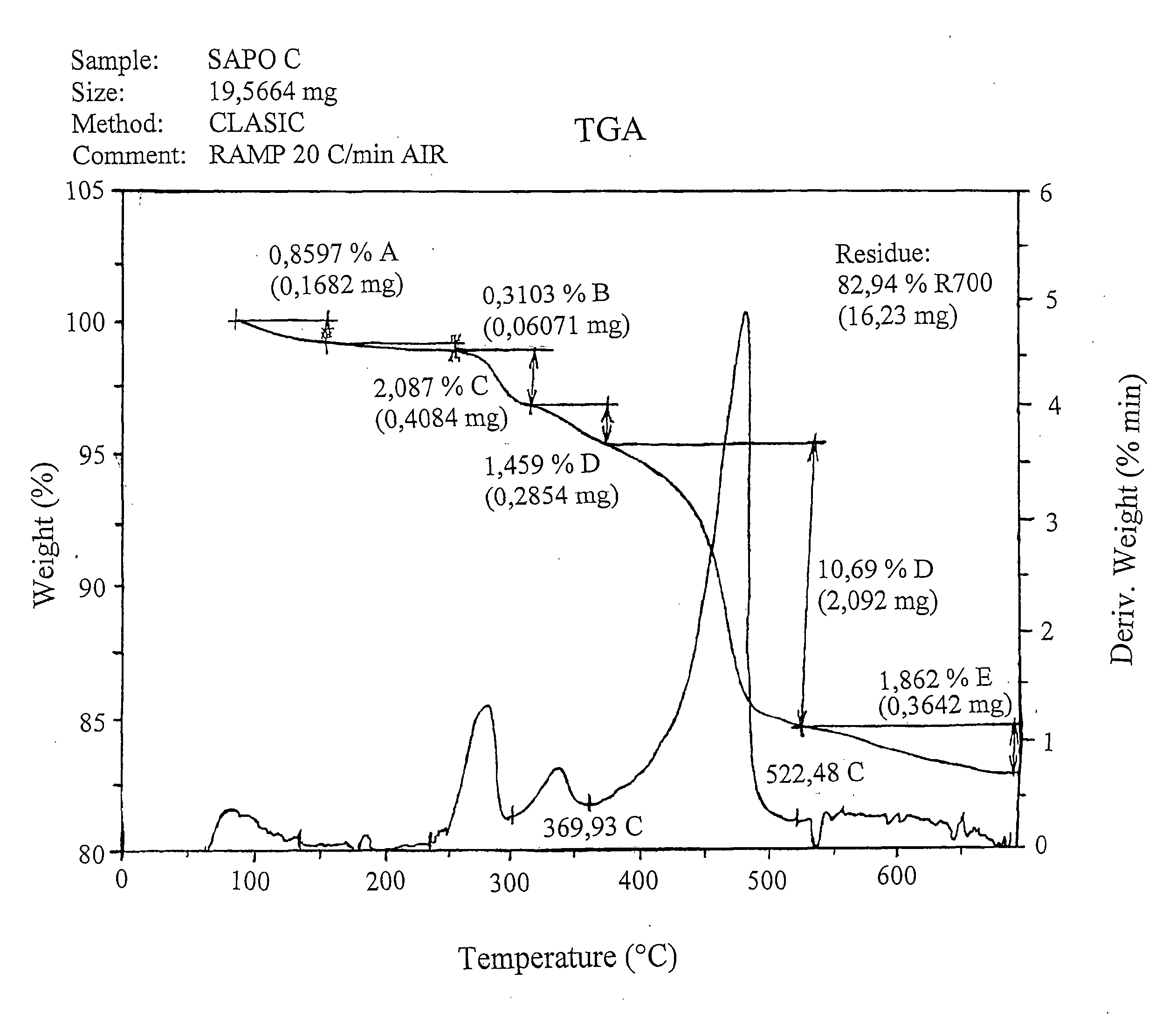Process for preparing silicoaluminophosphate (SAPO) molecular sieves, catalysts containing said sieves and catalytic dehydration processes using said catalysts
a technology of silicoaluminophosphate and molecular sieves, which is applied in the direction of ether preparation, combustible gas purification, filtration separation, etc., to achieve the effect of minimizing the synthesis cost and high yield
- Summary
- Abstract
- Description
- Claims
- Application Information
AI Technical Summary
Benefits of technology
Problems solved by technology
Method used
Image
Examples
example 2
Synthesis of Pure SAPO-34 Molecular Sieve
[0082]The synthesis was carried out identical to the described synthesis recipe of example 1. The pH was adjusted with ˜3 ml H3PO4 (85%). The yield after drying was 20 g (˜80% of the theoretical yield). Details of the total element and template amounts and ratios are given in Table 1.
TABLE 1Amounts and ratios used for the syntheses ofexamples 1 and 2.Ex.AlOOH×H3PO4SiO2TEAOHNo.H2OH2O(85%)H2OTemp.TimepH(25%)H2O(25%)H2OSum H2O1Gram100.011.2015.602.303.602.7040.7030.5135.5Mol5.560.14350.1350.1375242.600.0150.150.0691.77.54Ratio*1.061.000.110.4953.82Gram100.011.2020.653.063.602.7040.7030.5136.3Mol5.560.14350.1790.1775242.600.0150.150.0691.77.58Ratio*0.801.000.0840.38542.3*equivalent tofor Ex. 1: P2O5:Al2O3:SiO2:TEAOH:H2O = 1:1.06:0.22:0.98:107.6for Ex. 2: P2O5:Al2O3:SiO2:TEAOH:H2O = 1:0.8:0.17:0.77:84.6Note:the total amounts of H3PO4, SiO2-sol and TEAOH solution in gram include the separately listed H2O content of these chemicals (which is only li...
example 3
Synthesis of Pure SAPO-34 Molecular Sieve
[0084]100 g H2O and 11.2 g H3PO4 (85%) were mixed at 25° C. 11.2 g of pseudo-boehmite were added slowly at 25° C. under stirring. This suspension was heated to 75° C. and stirred for additional 24 h. After this time period 3.6 g SiO2-sol 25% and 40.7 g TEAOH solution (25%) were added at 75° C. under stirring. Immediately after the final addition of the Si— and Template sources the pH value was adjusted with conc. HNO3 (˜4 ml) to 6.8 at 75° C. The resulting final suspension was heated for 3 days at 185° C. in an autoclave, filtered, washed with H2O and dried at 110° C. for 12 h. Yield after drying 14 g (˜56% of the theoretical yield).
[0085]Details of the total element and template amounts and ratios are given in Table 1.
TABLE 2Amounts and ratios used for the syntheses ofexample 3.AlOOH×H3PO4SiO2TEAOHNo.H2OH2O(85%)H2OTemp.TimepH(25%)H2O(25%)H2OSum H2O1Gram100.011.2011.21.73.602.7040.7030.5135.5Mol5.560.14350.0970.0975244.200.0150.150.0691.77.5R...
example 6
Catalyst Formulation
[0092]140 g of SAPO powder as synthesized obtained according to the procedure given in example 1 or 2 (containing 100 g of dry matter, the balance being humidity) are mixed with 800 g of ammonia-stabilized colloidal silica at 8.5% SiO2. The suspension is stirred till it is homogeneous. The slurry is maintained under stirring and is atomised by spray drying in the following conditions:[0093]inlet air temperature: 420° C.[0094]outlet air temperature: 150° C.[0095]injection pressure 4 bar
[0096]The product is then submitted to calcination in air at 550° C. for 10 hours. In a first period the temperature is raised to 350° C. in 6 hours, and kept at this level for 2 hours, in a second period the temperature is raised to 550° C. with a heating rate of 2° C. / min and kept for 10 hours. The weight loss during calcination is about 30% of the initial weight. The final product is composed by spheres of an average particle size of 50-80 μm.
PUM
| Property | Measurement | Unit |
|---|---|---|
| Temperature | aaaaa | aaaaa |
| Temperature | aaaaa | aaaaa |
| Temperature | aaaaa | aaaaa |
Abstract
Description
Claims
Application Information
 Login to View More
Login to View More - R&D
- Intellectual Property
- Life Sciences
- Materials
- Tech Scout
- Unparalleled Data Quality
- Higher Quality Content
- 60% Fewer Hallucinations
Browse by: Latest US Patents, China's latest patents, Technical Efficacy Thesaurus, Application Domain, Technology Topic, Popular Technical Reports.
© 2025 PatSnap. All rights reserved.Legal|Privacy policy|Modern Slavery Act Transparency Statement|Sitemap|About US| Contact US: help@patsnap.com



